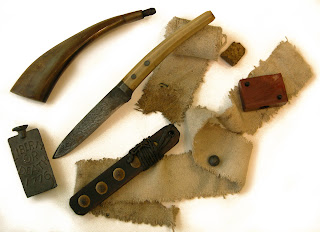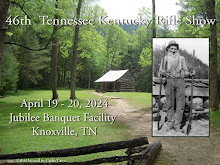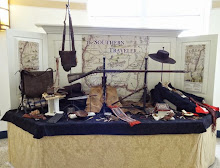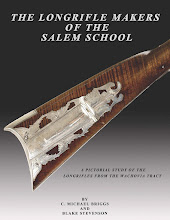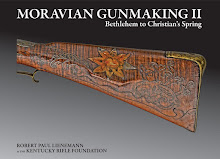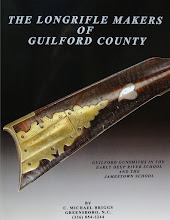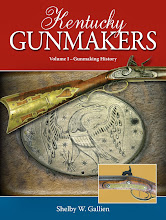Ponca Dress
This hand-stitched
woman's dress is made of medium-weight, coarse red and blue wool cloth. The
bodice of the dress is red and the skirt is blue. The white selvedge of the
blue cloth is visible at the side seams and hem of the skirt. The dress has a
high waistline and 3/4 length sleeves. The entire bodice is lined with a
printed, plain-woven cotton fabric that is white with small red dots. The
neckline is finished with blue and white plain-woven cotton gingham binding and
the sleeve edges are embellished with black silk satin ribbon. The entire front
and back of the bodice is covered with blue and white striped beadwork that is
stitched directly to the red wool cloth in the "lazy stitch." There
are beaded panels along the tops of the shoulders, which are executed on a
different red wool cloth than the rest of the bodice. The black and white
striped selvedges of these panels are visible at the neckline. These panels
have opaque white beadwork in a geometric and linear pattern. Below the
shoulder panels are two rows of tubular glass beads with painted silver
metallic interiors. There are applied semi-tanned hide fringes stitched around
the dress just above the waistline. The fringes are strung with opaque white
and black tubular glass beads.
The style of this
dress is uncharacteristic for this time periods and it resembles Blackfeet
dress styles. The narrow red shoulder bands were not visually characterized
because the weave structure is obscured by the beadwork and there are no areas
that could be sampled for dye identification. However, this cloth did
fluoresced bright orange under UV light. It appears as though these bands were
recycled from another object. They resemble beaded bands on bags made in the
Great Lakes region.
Wool, cotton, semi-tanned
hide, glass beads
Selvedge
Magnified
There are two cloths
being examined on this dress. Cloth A is the red wool cloth that the bodice is
primarily constructed from. It is a heavyweight wool plain weave with no
visible selvedge.
Blackfeet or Siksika Textile Square
This object is a small
rectilinear medium-weight, red wool textile that is hand-stitched. The white
selvedges are visible in the center seam beneath a strip of zigzag cut red
cloth, which is stitched over the seam. The textile is embellished with curvilinear,
floral beadwork that is stitched to the red cloth. The red wool is entirely
lined with a white, plain-woven cotton cloth. All of the outer edges are
finished with a dark blue twill woven binding.
This cloth may be
portions of a recycled men's apron. The beadwork motifs are more characteristic
of Plains Cree or Ojibwa than Blackfeet or Siksika.
Wool, cotton, glass
beads
Selvedge Magnified
The cloth being examined is a red wool cloth that the object is primarily constructed of. It is a medium-weight plain weave with a white selvedge.
The white selvedge of this cloth is resist-dyed. The resist-stitch holes are visible at the dye line.
Fox Dance Bustle
Description:
This dance bustle is primarily constructed from a coarse red wool cloth.
However, the foundation at the top back of the bustle is made of a thick piece
of yellow and red painted rawhide, which appears to be a recycled portion of a
parfleche. There is finely woven red wool cloth covering the foundation of the
bustle and several semi-tanned hide thong straps that function as a means of
attachment for the wearer. The bustle has two long red wool trailers, which are
almost entirely covered with black feathers. The white selvedges of this cloth
are visible at the bottoms of the trailers. There are two spikes extending from
the top of the bustle that are heavily embellished with: black horse hair
wrapping, dyed quills, dyed white tail deer fur, feathers, semi-tanned hide
fringes, white metal cone tinklers, dew claws, glass beads and fur. There are
also three white metal broaches attached to the top of the bustle.
Dance
bustles like this one are usually made with eagle, hawk, or owl feathers. This
object tested negative for arsenic residue. Test locations are noted in the
object file.
Wool,
rawhide, semi-tanned hide, feathers, horsehair, quills, white metal, horn, fur,
glass beads
Selvedge Magnified
Both red cloths on the
bustle are being examined. Cloth A is the red cloth of the trailers that has a
white selvedge. It is a medium-weight, coarse balanced plain weave. Cloth B is
the red cloth that is covering the foundation at the top of the bustle. This
cloth is lighter in weight and more finely woven that the cloth described
above. It is also a balanced plain weave.
The white selvedge of
Cloth A is resist-dyed. The resist-stitch holes are visible at the dye line.
Cloth B does not have any visible selvedge edges.
Both red cloths on the bustle are being examined. Cloth A is the red cloth of the trailers that has a white selvedge. It is a medium-weight, coarse balanced plain weave. Cloth B is the red cloth that is covering the foundation at the top of the bustle. This cloth is lighter in weight and more finely woven that the cloth described above. It is also a balanced plain weave.
Nez Perce or Sahaptin Quiver
This very large and
heavy quiver has a long outer panel made primarily from hand-stitched pieced
course red wool cloth, which is entirely lined with lightweight, plain-woven
cotton. The selvedge is visible along the bottom edges of the outer panel. Fur
pelts (that appear to be otter) are stitched to the entire panel. There is
beadwork in diagonal lines and chevrons in opaque blue and white beads in on
the face of the red wool cloth. Tubular pendants hang from the center sides of
the outer panel. The pendants are heavily beaded with geometric motifs executed
in "lazy stitch" on semi-tanned hide. The top and bottom edges of the
pendants are trimmed with red wool cloth binding. There are long fur trailers
hanging from the bottom of each pendant. The pendants are stitched to the outer
panel and the quivers with semi-tanned hide thongs. There are short green, red,
yellow, and blue ribbon streamers stitched to the animal pelts on the outer
panel. The bow case and quiver are located beneath the outer panel are
constructed from animal pets stitched into a tubular bags. The top openings are
finished with striped beadwork in "lazy stitch" on semi-tanned hide
that was applied to the opening edges of the quivers. Each quiver has a long
geometric beadwork panel attached at the opening. The quiver panels were beaded
and edged with red wool cloth in the same techniques described above. The
bottoms of the quivers are also decorated with beadwork and have fur trailers
similar to the tubular beaded pendants on the outer panel. The quivers are
stitched together and to the outer panel with semi-tanned hide thongs.
A horseback rider
would have worn this quiver over the shoulder. This piece is rare and that few
of such quality exist in museum collections. This object tested negative for
arsenic residue. Test locations are noted in the object file.
Selvedge Magnified
The cloth being examined is a coarse red wool cloth that the quiver is primarily made of. It is a heavyweight, plain weave with a white selvedge.
Copy and photos NMAI.












































